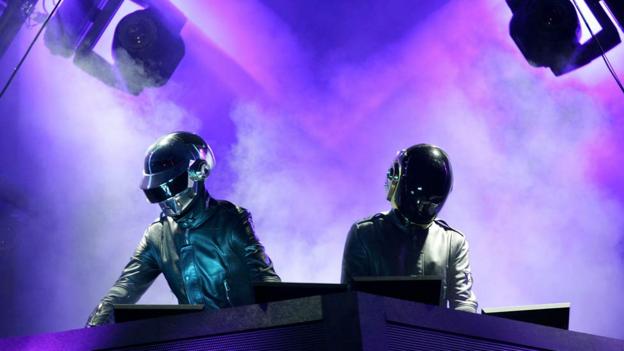
Getty Images
Rave mania swept Europe in the late ‘80s, but dance music has always failed to take off in the United States – until now. Greg Kot explains why.
Just when electronic dance music (or EDM) appears to be having its big moment in North America after decades of neglect, along come Daft Punk to say, “Not so fast.”
Daft Punk founders Thomas Bangalter and Guy-Manuel de Homem-Christo are in many ways the godfathers of the current EDM/dubstep surge, and star DJs such as Skrillex and Nero owe them their careers. With a series of house-centric albums and an awe-inspiring 2006-7 tour that situated the French duo inside a neon pyramid, Daft Punk ushered in the third major wave of dance music since rave mania swept Europe in the late ‘80s. But their latest album, Random Access Memories, thumbs its nose at what Bangalter has called the personality-free tropes of EDM.
On the album’s track, Touch, Paul Williams plays a robot in search of a soul: “You’ve almost convinced me I’m real,” he sings, but “I need something more.”
Bangalter has said in interviews that EDM also needs ‘something more’ if it expects to have staying power. For the last two years, it’s been the fastest-growing musical genre in North America, after decades as a pariah.
The animosity dates to the ‘70s, when ‘Disco sucks’ T-shirts sprouted up among the rock brigades greeting the arrival of Saturday Night Fever in North America. In the ‘80s, Chicago house and Detroit techno helped spawn a huge European rave scene – which flourishes to this day – but remained underground back home. In 2000, the city of Chicago passed what became known as the ’anti-rave’ ordinance, which made property owners, promoters and DJs subject to $10,000 fines for being involved in an unlicensed dance party. In 2003, the U.S. Congress passed the Illicit Drug Anti-Proliferation Act, which cracked down on parties associated with drug use and authorised funds to educate parents and kids on the dangers of Ecstasy, a drug associated with the dance scene.
Going straight
What a difference a decade makes. The scene has shed baggage from its outlaw days as promotion, security and crowd control have gone legit. With professionals in suits now running the business, audiences have expanded and corporate dollars have begun to flow. Massive dance festivals such as the Electric Daisy Carnival routinely draw more than 300,000 fans for a weekend in Las Vegas, and the franchise recently expanded to Chicago and London for the first time.
Electric Daisy founder Pasquale Rotella says he’s received offers as high as $120 million to sell his Insomniac promotion company and is exploring a longer-term partnership with rock concert promoter Live Nation, which could expand dance music into stadiums and amphitheatres in most major North American markets.
Rotella says the Internet played a huge role in expanding EDM’s reach and helped bring young fans out to American shows in record numbers. Clearly, the electronic music scene radiates a glow stick energy that makes a lot of current rock and hip-hop sound staid. At Lollapalooza festival over the last few years, EDM acts such as Bassnectar and Calvin Harris have gone head-to-head against rock bands on other stages, and have drawn huge, frenzied audiences numbering in the tens of thousands.
Disco inferno?
Not since the brief blip of disco mania in the late ‘70s has dance music been such a commercial force in America. But can it last? In a recent talk at the South by Southwest Music Conference in Austin, Texas, electronic music innovators Richie Hawtin and Joel Thomas Zimmerman, also known as Deadmau5, sounded some warning bells.
No comments:
Post a Comment